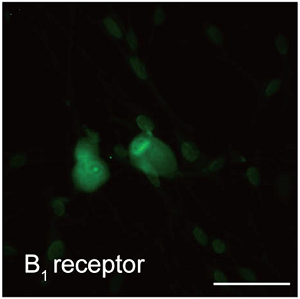Overview
- Peptide (C)KEAS RTR*SG GPKGS K, corresponding to amino acid residues 243-257 of rat B1R with replacement of cysteine 250 (C250) with serine (*S) (Accession P97583). 3rd intracellular loop.
- Rat brain and heart lysates (1:200-1:1000).
 Western blot analysis of rat brain (lanes 1 and 3) and heart (lanes 2 and 4) lysates:1-2. Anti-B1 Bradykinin Receptor (BDKRB1) Antibody (#ABR-011), (1:200).
Western blot analysis of rat brain (lanes 1 and 3) and heart (lanes 2 and 4) lysates:1-2. Anti-B1 Bradykinin Receptor (BDKRB1) Antibody (#ABR-011), (1:200).
3-4. Anti-B1 Bradykinin Receptor (BDKRB1) Antibody, preincubated with B1 Bradykinin Receptor/BDKRB1 Blocking Peptide (#BLP-BR011).
- Rat cerebellum and amygdala (brain frozen sections), (1:50).
Mouse spinal cord (1:200), (Dutra, R.C. et al. (2013) Neurobiol. Dis. 54, 82.).
- Rat trigeminal neuron primary cultures (Kawaguchi, A. et al. (2015) Front. Cell. Neurosci. 9, 229.).
Kinins are small peptides rapidly produced following tissue injury that serve as important modulators of inflammation and pain. In the periphery, the actions of kinins include vasodilatation, increased vascular permeability, stimulation of immune cells, and induction of pain. Kinins in the central nervous system (CNS) appear to initiate a similar cascade of events leading to neural tissue damage as well as long lasting disturbances affecting blood-brain barrier function.1
Kinins such as Bradykinin (BK), Lys-BK, desArg9-BK, and Lys-desArg9-BK exert their action via two distinct receptors: the B1 Bradykinin receptor (BKRB1) and the B2 Bradykinin receptor (BKRB2). The desArg9-BK and Lys-desArg9-BK peptides activate BKRB1 while BK and Lys-BK operate by activating BKRB2.2 Both BKRB1 and BKRB2 are members of the seven-transmembrane domain, G protein-coupled receptor (GPCR) superfamily and share a common structure of seven putative transmembrane domains, an extracellular amino terminus, and a cytoplasmic carboxyl terminus.
Expression of BKRB1is inducible upon various types of tissue injury and by inflammatory mediators such as bacterial lipopolysaccharide (LPS) and cytokines. BKRB1 was long considered not to be expressed in healthy tissues. However, recent work has demonstrated a low level of expression of BKRB1 in the CNS of rodent and primates. In contrast, BKRB2 is constitutively expressed on various cell types.3 BKRB1 represents a potential therapeutic target for treatment of inflammatory disorders and cardiovascular diseases.
Application key:
Species reactivity key:

Expression of B1 bradykinin receptor in rat TG neurons.Immunocytochemical staining of rat primary trigeminal ganglion (TG) neurons using Anti-B1 Bradykinin Receptor (BDKRB1) Antibody (#ABR-011). Adapted from Kawaguchi, A. et al. (2015) Front. Cell. Neurosci. 9, 229. with permission of Frontiers.
